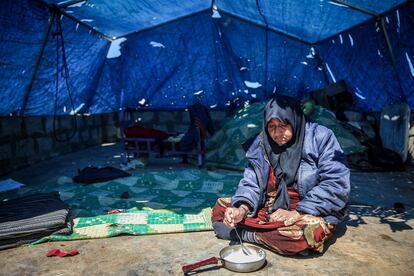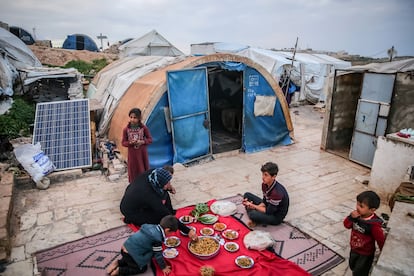In Syria, people fear hunger more than bombs
On the 12th anniversary of the war, the population is suffering more from food insecurity and poverty now than in the toughest moments of the conflict. And the forecasts for 2023 are even worse due to the earthquake

“The number of people on the brink of food insecurity in Syria is growing the fastest.” This is how Benjamin Flórez, senior adviser in Damascus for the United Nations World Food Programme (WFP), explains the situation in Syria. According to the institution, more than 12 million Syrians suffer from food insecurity — more than half the population, although this figure could increase by another three million in 2023, especially after the impact of the February earthquakes that affected some of the most vulnerable populations in Syria as well as important agricultural areas.
The WFP offers aid to 50% of those more than 12 million people who suffer from hunger, but due to the lack of funding, it has had to reduce the size of the baskets of basic products that it distributes each month to 5.5 million Syrians. “We include lentils, which is a vegetable protein, but other proteins have to be bought” in the market, where prices have skyrocketed in the past three years. “A mother told me that she had not been able to buy meat for five years,” says the WFP adviser, noting that such high percentages of child and maternal malnutrition had never been recorded in Syria, reaching 25% in some areas of the country.
Such high percentages of child and maternal malnutrition have never been registered in Syria, reaching 25% in some areas of the country
The situation is especially worrying in northwestern Syria, where 4.5 million people are concentrated — including almost three million internally displaced persons — as Daher Zidan, the executive director in Turkey of the Union of Medical Care and Relief Organizations (UOSSM), pointed out to this newspaper. Member NGOs operating in opposition-controlled areas have seen an increase in cases of malnutrition among children under five, as well as among pregnant and lactating mothers. “We are working to raise awareness among mothers about their nutrition and that of their children, in addition to offering food supplements, energy cookies and other types of treatments,” he explains.
Although in the capital, Damascus, the crisis is not as acute, hunger does not distinguish between the areas under the government of Bashar al-Assad and those that still escape his control, according to Flórez. “The Syrians I’ve asked say they are more concerned about the economic crisis, having food on the table every day and making ends meet, than about the conflict.” In fact, levels of violence have dropped markedly: last year was the least deadly since March 2011, according to the NGO Syrian Observatory for Human Rights, which documented the deaths of some 1,600 civilians, including 23 children and 10 women because of “poor health conditions.”
The consequences of the war in Ukraine
“The conflict did not generate hunger; when the conflict affected the whole country, people were not so hungry, but it was the main cause, to which one crisis after another has been added,” notes the WFP adviser, alluding to the years of civil war, the economic crisis in Lebanon since 2019 — which had a great impact on the Syrian economy, dependent on the neighboring country — the Covid-19 pandemic and the war in Ukraine. Since the Russian invasion of that country, food prices in Syria have doubled and this upward trend is expected to continue, even as the local currency keeps depreciating along with citizens’ ability to meet their most basic needs. The price of wheat flour has risen by 20% in government areas hit by the earthquake, where WFP supports the network of government-subsidized bakeries.
The average salary in Syria only covers a quarter of the purchase of a family of about five members
Flórez points out that the average salary in Syria only covers a quarter of the necessary purchases for a family of five and, if chicken meat is added to the shopping cart, a teacher’s entire salary vanishes. There are those who can still afford to eat meat, although fewer and fewer individuals are that privileged, even among Syrians who have remained faithful to the regime out of conviction, coercion or personal interests.
In Damascus, Maha boasts that she can still buy chicken, which sells for around 50,000 Syrian pounds (about $20 at the official exchange rate). “I still have the chance, four of my daughters live abroad and they send me money,” says the 56-year-old former primary school teacher, who prefers not to reveal her last names. She lives in the capital with her other two daughters — “I have six girls and my husband,” she says proudly — and she admits that they are lucky. She figures that an average family needs a million Syrian pounds (about $400) to survive, but if they buy meat or fruit, that figure doubles or more. Fresh produce is the most expensive, but cereals have also skyrocketed. “Everything has increased, from bulgur [made from wheat] to rice, which has risen from 3,000 to 10,000 Syrian pounds [$1.19 to $3.98],” she says, while also blaming this price increase on speculation. “Five years ago prices were normal, everyone could afford everything,” she recalls, “but in the last year the situation has completely changed.”

The earthquake will cause more hunger in 2023
The earthquake will only make this dramatic situation worse: the first damage assessments suggest that food production will be “seriously affected,” as the WFP’s Food Security Cluster points out in its latest report: houses and farms have been damaged, including irrigation systems, and agricultural machinery and already very low reserves of fuel have been used for rescue efforts.
The chief technical adviser for Syria of the Food and Agriculture Organization of the United Nations (FAO), Alfredo Impiglia, stated in an interview with this newspaper that the earthquake will increase the rate of food insecurity, especially in the northwestern provinces, where there are some 50,000 hectares of cultivated fields. “There will be an immediate repercussion on the next wheat harvest, because the population is focused on the emergency, on helping relatives and rebuilding their homes, so they won’t have money to invest in pesticides or gasoline for tractors.” In the affected areas alone, the FAO calculates that some three million farmers need help and the World Bank estimates that this is the sector that has registered the greatest economic losses and will need the greatest investment: 27% of the almost $8 billion that this body considers will be needed for recovery and reconstruction in the next three years.
The World Bank estimates that the agricultural sector has registered the greatest losses and will need the greatest investment to recover
Impiglia, who has known Syria since the 1990s, says bitterly that “the country is destroyed”: it has gone from being self-sufficient and exporting part of its agricultural production to being among the six countries with the greatest food insecurity in the world, with a strong dependence on imports. The lands that in ancient times were part of the fertile crescent of the Levant, generated just over a million tons of wheat in 2022, compared to almost four million before the conflict, explains the FAO expert.
The increasingly frequent droughts — in 2018, 2021 and 2022 — have also affected production, as has damage to infrastructure (silos, irrigation systems...) and agricultural machinery, which has often been stopped due to lack of fuel. Seeds and fertilizers have been in short supply or of lesser quality due to the conflict. “There are many factors that have contributed to the low productivity, including the depreciation of the local currency and the sanctions [European and American] that have limited the import, not only of pesticides, but even of seeds,” he says in disbelief.
Scorched earth policy
The political factor cannot be ignored in a conflict like the one in Syria, in which President al-Assad “has punished the entire population for rebelling against him 12 years ago,” says Muhsen al-Mustafa, an analyst associated with the think tank Tahrir Institute for Middle East Policy (TIMEP) in Washington.
“Specifically, the rural and agricultural populations were important propellers of the revolution, unlike the pro-government areas,” explains the Syrian expert. “To this is added that many citizens have been displaced by the regime’s repression and indiscriminate land and air attacks on their towns, including farmland,” from which about 50% of the population obtained some kind of livelihood.
“The fuel shortage in the past decade has also greatly affected agriculture,” adds Al-Mustafa, who believes that the Assad government currently does not have the means or the technical staff to relaunch the sector, apart from “corruption that affects all government agencies.” And he underscores that “the most important thing for the regime was to stay in power. For this reason, it has neglected all the areas of development for the country.”
Sign up for our weekly newsletter to get more English-language news coverage from EL PAÍS USA Edition
Tu suscripción se está usando en otro dispositivo
¿Quieres añadir otro usuario a tu suscripción?
Si continúas leyendo en este dispositivo, no se podrá leer en el otro.
FlechaTu suscripción se está usando en otro dispositivo y solo puedes acceder a EL PAÍS desde un dispositivo a la vez.
Si quieres compartir tu cuenta, cambia tu suscripción a la modalidad Premium, así podrás añadir otro usuario. Cada uno accederá con su propia cuenta de email, lo que os permitirá personalizar vuestra experiencia en EL PAÍS.
¿Tienes una suscripción de empresa? Accede aquí para contratar más cuentas.
En el caso de no saber quién está usando tu cuenta, te recomendamos cambiar tu contraseña aquí.
Si decides continuar compartiendo tu cuenta, este mensaje se mostrará en tu dispositivo y en el de la otra persona que está usando tu cuenta de forma indefinida, afectando a tu experiencia de lectura. Puedes consultar aquí los términos y condiciones de la suscripción digital.
More information
Archived In
Últimas noticias
Most viewed
- Reinhard Genzel, Nobel laureate in physics: ‘One-minute videos will never give you the truth’
- Oona Chaplin: ‘I told James Cameron that I was living in a treehouse and starting a permaculture project with a friend’
- Pablo Escobar’s hippos: A serious environmental problem, 40 years on
- Why we lost the habit of sleeping in two segments and how that changed our sense of time
- Chevy Chase, the beloved comedian who was a monster off camera: ‘Not everyone hated him, just the people who’ve worked with him’










































